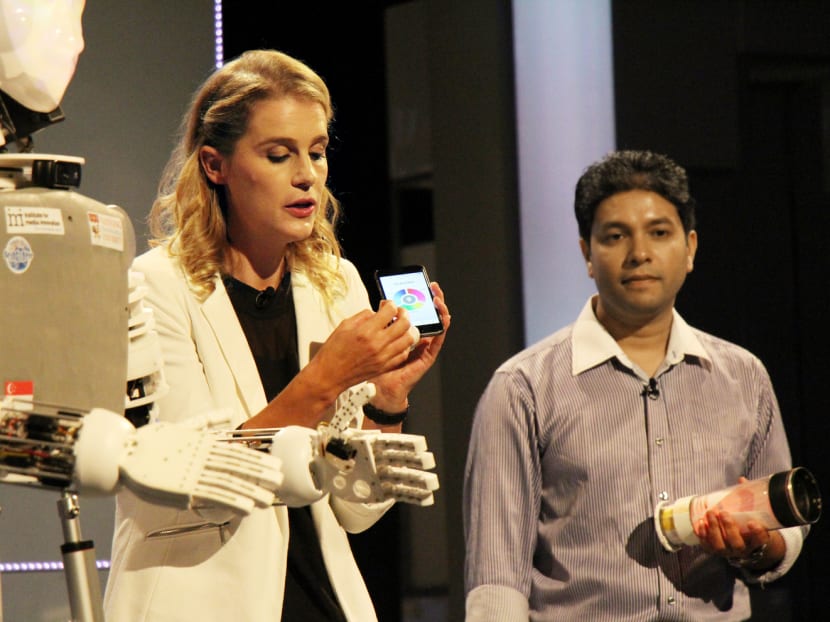Household hacks could help solve big engineering challenges
SINGAPORE — Create a macro lens for your smartphone with just a laser pointer and rubber wristband or build a projector at home with a mobile phone, magnifying lens and shoebox. Listening to music on your phone and it’s too soft? Slot the phone into a slit made on a toilet roll, or create “speakers” from kitchen rolls.

Professor Danielle George and Keio-NUS CUTE Center's Dr Nimesha Ranasinghe using EDGAR the robot developed by NTU's Institute for Media Innovation to showcase how ingenious, creative and innovative engineering can be. Photo: MediaCorp TV
SINGAPORE — Create a macro lens for your smartphone with just a laser pointer and rubber wristband or build a projector at home with a mobile phone, magnifying lens and shoebox. Listening to music on your phone and it’s too soft? Slot the phone into a slit made on a toilet roll, or create “speakers” from kitchen rolls.
This concept of “hacking” one’s home — using an array of old and new gadgets to invent, and re-invent — gets people to take control of the technology around them and think creatively, and is a step towards ultimately finding solutions to some of the world’s engineering challenges, believes Professor Danielle George, Associate Dean for Teaching and Learning at the University of Manchester’s Faculty of Engineering and Physical Sciences.
Prof George, who is also a professor in the Microwave and Communications Systems research group at the university, was in Singapore in July for the Singapore Science Festival, where she presented her 2014 Christmas Lecture for the Royal Institution of Great Britain.
Her lecture included showing how three British inventions — the light bulb, the telephone and an electric motor — can be adapted and transformed.
More than 1,500 students in Singapore, aged between 13 and 18, attended the session.
Hacking one’s home is “all about old and new materials, online collaboration and controlling devices through coding”, said Prof George, adding that it is also about having fun. While she was initially “a little apprehensive” about how the students in Singapore would respond to her lecture, Prof George told TODAY she found the students here to be “very advanced in terms of their ability and passion to tinker with gadgets at home and hacking the every-day technology around them”.
She added: “There were always a number of really enthusiastic volunteers for all of our experiments — even when it came to tasting an electronic spoon!”
Prof George said her 2014 Christmas Lecture gave her the opportunity to highlight how “ingenious, creative and innovative engineering can be”.
“I want to help change the perception some people have of the field — engineers don’t just fix things, they create things. I hope the lectures encourage and inspire more young people to take up this exciting and challenging profession,” she stressed.
Prof George is currently involved in designing, testing and constructing instruments used in radio frequency and microwave communications systems. “One of the things I love most about my research is the extraordinary variety of ways it can be applied to solve real-life problems and challenges,” she enthused.
Prof George has worked on highly sensitive instrumentation for NASA physicists. She has also worked with agriculturists to develop devices to accurately measure usage of water, and with Rolls Royce on its industrial gas turbine engines.
“Today’s generation of young people are in a truly unique position. They have never been more equipped to be creative and innovative. I want young people to realise that they have the power to change the world from their own bedroom, kitchen table or garden shed,” said Prof George, who is currently devising a monitor and perimeter alarm system using her mobile phone and a simple electronics kit “for when my nine-month daughter starts crawling around the house!”
STAR Lecture 2015: Sparks Will Fly: How to Hack Your Home by Prof Danielle George, will be broadcast on Channel 5 on Oct 19, at 6.30pm.
CLARIFICATION: EDGAR the robot is developed by NTU's Institute for Media Innovation and not Keio-NUS CUTE Centre as the previous photo caption may have implied.





